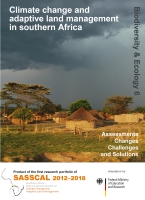
|

Department of Biology Institute of Plant Science and Microbiology |
| Division BEE > Biodiversity & Ecology > Vol.6 > Article 1.6 |
Biodiversity & Ecology
Journal of the Division Biodiversity, Evolution and Ecology of Plants , Institute for Plant Science and Microbiology, University of Hamburg.
Climate Research article Open Access SASSCAL WeatherNet: present state, challenges, and achievements of the regional climatic observation network and database
Resumo: As estações meteorológicas automáticas (AWSs) servem uma série de fi ns no contexto do SASSCAL e mais além. São necessárias uma cobertura e densidade sufi cientes no espaço geográfi co para registar a variabilidade espacial climática e alimentar os modelos climáticos e serviços de previsão. Além disso, projectos de investigação que usam uma abordagem ecossistémica requerem informação robusta sobre as condições meteorológicas locais. Em resposta a estes objectivos, e considerando a baixa densidade de estações climáticas na região do SASSCAL (Angola, Botswana, Namíbia, África do Sul e Zâmbia), foi iniciado o estabelecimento de uma rede de estações meteorológicas em 2009-2010. Entretanto, a rede do SASSCAL inclui 154 AWSs e alcançou uma reputação de proporcionar progresso sem precedentes em termos de cobertura e acesso a dados climáticos para a região do SASSCAL. Este artigo apresenta as etapas estratégicas e técnicas mais importantes, desde a criação da rede de estações para a transmissão e controlo da qualidade dos dados até à publicação online dos dados climáticos da SASSCAL WeatherNet.
Suggested citation: |
